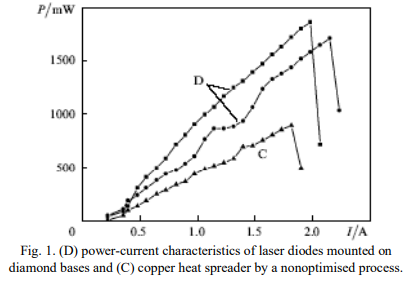Laser diodes and diode bars having output powers from a few to tens and hundreds of watts require effective heat removal from the active region of the semiconductor heterostructure. It was shown as early as the late 1960s that diamond crystals can be employed as effective heat sink bases for semiconductor lasers. The thermal conductivity of diamond is one of its most remarkable properties. It exceeds by several folds the thermal conductivity of all other solid materials: metals, semiconductors and dielectrics, including copper, which is used most frequently to remove heat in electronics. Diamond is also applied as a highly effective heat sink material in other semiconductor devices, such as avalanche and Gunn diodes.
Super hard materials, including diamond, are composed of atoms in stable electronic configurations and are nonreactive with most metals and solders. Adequate adhesion to diamond might be offered by metals that have high chemical affinity for carbon, preferably those that form carbides possessing metallic bonding and metallic properties (chromium, titanium, niobium, zirconium, tantalum, molybdenum and tungsten). The development of a process for applying high-adhesion metallic coatings to diamond is an important practical issue.
Ti-Ni-Ni was used as a model system to establish conditions for the preparation of uniform, high-adhesion metallic coatings on a diamond base with the required low resistivity relative to all exposed surfaces. Similar results were obtained in the other systems.
DHS’s were metallized as follows: First, a Ti underlayer was grown on diamond by low-pressure plasma deposition from a charge-separated plasma, followed by chemical deposition of a Ni layer from an electrolyte solution. Next, Ni was deposited by ion beam (or magnetron) sputtering until the coating had the desired thickness. These techniques were used to develop a mounting process for diode lasers and bars. The best results were obtained when metallic coatings on the components of laser structures were produced by ion beam sputtering.

The vacuum processes developed by us for producing metallic coatings firmly adherent to various surfaces take advantage of multifunctional ion beam and magnetron sputtering systems and employ interstitial alloys with high affinity for carbon as adhesive layers. Metallization was performed using a purpose-designed sputtering system, which allowed surface treatment with an about 1 keV argon ion beam prior to film growth.
The developed chemical and vacuum techniques apply to copper and diamond heat sinks for diode lasers. Conditions have been optimized for mounting diode lasers and bars using the proposed metallization processes. The power output of CW laser diodes on diamond heat sinks increases by up to a factor of 2, the linear (working) portion of their power-current characteristic becomes markedly broader, and their slope efficiency increases by a factor of 1.5-2.0 relative to that of lasers on copper heat spreaders. The use of diamond heat sinks extends the drive current range of pulsed diode bars by a factor of 2-3 and enables them to operate at more than one order of magnitude longer pump pulse duration (up to milliseconds) when the pulse repetition rate is at least 10 Hz.
CSMH is a wide band gap semiconductor material company manufacturing with unique technology. The thermal conductivity of diamond heat sink is as high as 1000-2200W/(m·k) and CSMH can provide diamond heat sink TC 1200, TC 1500, TC 1800 and TC 2000.
 闽ICP备2021005558号-1
闽ICP备2021005558号-1Leave A Message